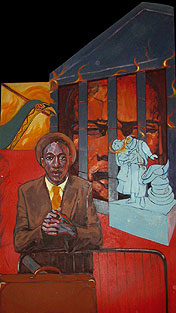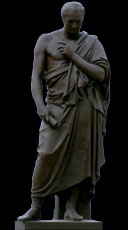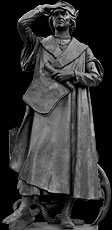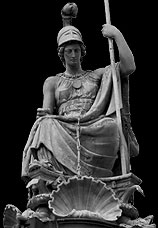
| HOME |
| NERVE |
| REVIEWS |
| ARCHIVE |
| EVENTS |
| LINKS |
| ABOUT US |
| CONTRIBUTORS |
| BACK ISSUES |
| CONTACT US |
Back to index of Nerve 9 - Autumn 2006
 “All
the public art in Liverpool reflects a white dominated society, and it
would be good for the city to counter the negative representations of
black people, and black people’s art, by commissioning a piece of
public art by a black artist.”
“All
the public art in Liverpool reflects a white dominated society, and it
would be good for the city to counter the negative representations of
black people, and black people’s art, by commissioning a piece of
public art by a black artist.”
City of Ghosts
Paul Clarkson describes himself as an artist of history. He wants to
see some public art, created by black people, put up in Liverpool.
Paul has been working on a project about twin African spirit dolls, touring
the city and commenting on the statues and monuments that represent colonialism.
“The dolls are Ibeji, spirits of twins: that is, they are two halves
of two twins, one male and one female. They originate from the Yoruba
tradition of Nigeria, where they once adorned shrines set up in their
honour, for they were protectors of home, women and children in their
original homelands. Twins have a special place in the lives of people
all over Africa; they are like the yin and yang of the Chinese tradition,
bringing balance to extremes.”
Here is a small part of this work.
 William
Huskisson
William
Huskisson
(Rope Walks, previously, Princes Road)
An early l9th century Liverpool MP, he canvassed for the “freemen”
of the city on issues of trade and commerce when Britain had an Empire
of colonies and populations it wanted to exploit. The development of the
railway had become more useful to the development of this infrastructure,
and Huskisson, who saw it as the way forward, was killed by the famous
Stephenson’s Rocket locomotive, at the launch of the opening of
a new rail line. His statue once stood on the Boulevard on Princes Avenue
until it was pushed over in 1981 during the Toxteth uprisings. It was
recently restored to public view outside Maritime Housing’s Duke’s
Terrace development in the Rope Walks.
An article in the Liverpool Echo 1st December 2005 says, “It was
pushed over by protesters who believed Huskisson had been involved in
the slave trade”. The truth of the matter would be more that the
monuments were of no relevance to the lives of the people who live in
the area, and that they reflected a glorification of a past/present white
male-dominated council.
 Christopher
Columbus
Christopher
Columbus
(The Palm House, Sefton Park)
On 3rd August 1492, Columbus set off, in command of the Santa Maria,
across the Atlantic. On the 1st October he reached what is now known as
Cuba, and then Haiti, where he left garrisons before returning to Spain.
The council removed the statue in 1981, as they feared it would meet the
same fate as Huskisson. It was replaced in 2000. It is strange that this
monument should read, “the discoverer of America was the Maker of
Liverpool.” So not only did he set in motion the genocide of the
indigenous people of the Americas, but he is here also given the responsibility
of spearheading the city’s rise to wealth.
 Britannia
Britannia
(Various sites around the city, from the tops of buildings, such as the
Walker Art Gallery and the Town Hall on Castle Street, to reliefs on the
museum and war monuments)
A mythical Roman deity symbolising a sea goddess. Her name is sung in
a well known anthem, ‘Rule Britannia, Britannia rules the waves,
Britons, never, never, never shall be slaves.’
Yet they were happy to enslave others.
Paul has strong views about what should be done with the African art
lying in the museums of Merseyside. He refers to Ben Okri, the Nigerian
writer, who described what is lost, when works of art are taken from the
place that they were created.
“First of all the works of art are put in a permanent exile, one
half of them dies. Secondly the people themselves are exiled from the
repository of their dreams, they are exiled from the highest significance
that years of ritual evolution, social evolution and artistic evolution
have given rise to. This divorce means that the land does not grow in
the same way.
“The strangest thing that one set of people can do to another is
destroy their spirit and one of the tragic ways of destroying a people’s
spirit, is to destroy the validity of their works of art...”*
Paul adds: “To give the National Museums of Merseyside their due,
they have raised the issue of this stolen art. But they are using words
like ‘repatriation’ and this is setting the debate up to fail.
Repatriation is an emotive word, like Enoch Powell’s ‘send
them back’. I would rather see the word ‘reparation’
used.”
What should happen to this art is an ongoing debate that Nerve will return
to.
*Comments on the Benin Bronzes, from ‘Behind the Mask’, Hidden Empire Series, BBC/M-Net.
Sorry Comments Closed
Comment left by Andrew morgan on 21st July, 2009 at 22:38
Think your art is like my old mate brothers?
Same name if so good too see your work where
it be longs if not sill very good on the same lines
as him we're you next ?
Comment left by The Old Brit on 25th July, 2009 at 18:45
I thought I'd just point out that it's actually MINERVA (Godess of wisdom) who sits atop Liverpool Town Hall.